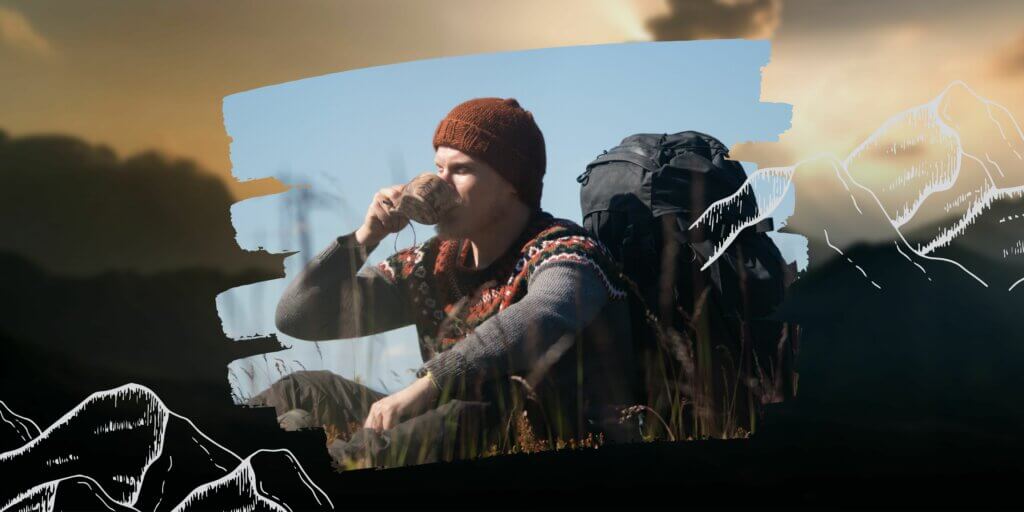
Towards the Fell Challenge
I hadn’t even unpacked from my previous trip when I was already looking forward to the next one. The thirst for adventure was strong, but my wilderness and nature guide training was already speeding towards its summer break. My kayaking trip at Liesjärvi left a void. So, what now? The words of my course instructor kept spinning in my mind: “80% of learning is self-study, and you have to find your own practice locations.” That’s some serious stuff, I’d say.
A lot is expected of a student. Quickly, my backpack feels heavier by a few credit points. Where and how can I gain as much experience and knowledge as possible to complement the lessons during campus days? During the training, I still need to build good contacts and find clients for various assessment tasks. Fortunately, my instructor Heikki always brings up the topic of internships and how the quick eat the slow. Nature is harsh. In our discussions about good internship opportunities, Kiilopää and Suomen Latu kept coming up.
It didn’t take long before I was sending an email to Kiilopää’s lead guide, Satu Salminen. Our conversation immediately found common ground. Heikki was right, it was good to be early. Setting the dates for the internship and assessments was also very easy and quick. Hyria students have clearly interned there before. At that moment, I felt a sense of relaxation. And about five minutes later, I had already signed up for the Fell Challenge at Kiilopää. I’ll be volunteering at the event and writing a blog about my experiences. I plan to share not only about the Fell Challenge itself but also about my preparation for the trip, Kiilopää’s hotel, and finally, a summary of the entire journey.
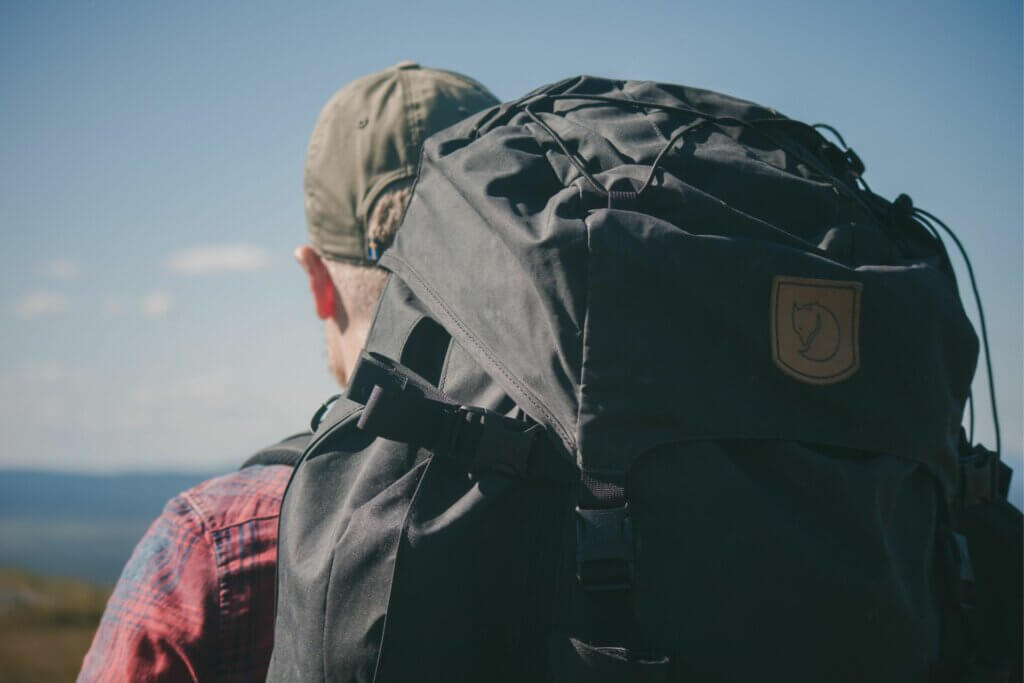
Part 1: It's Not the Destination, But the Journey
I’m not sure how long one should prepare for a week-long trek like the Fell Challenge. I registered about two weeks before the event began. Right after signing up, I received an information letter and details about the required gear and schedules. Additionally, I was invited to a group discussion where I could easily ask for more information about the event or simply get to know the other participants. The gear list was also quite comprehensive. I noticed a little bit of excitement bubbling inside me. Various “what if” scenarios began forming in my head. Whatever the weather, the journey must not stop. Sleep didn’t come easily. The feeling was expectant!
Luckily, before heading to Kiilopää, I had the opportunity to test and practice my skills in a safe environment with the school group. They provided me with the final tips and encouragement I needed before the trip. The beautiful hills and housing exhibitions with “suspended buffets” would soon be replaced by a more rugged landscape.
There’s this feeling that I’m representing something bigger. Now it’s my turn to share stories and lessons learned from the Luirojärvi and the climb to the top of Sokosti. The last missing pieces of gear have been gathered, and my belief that I can do this has grown stronger. I’ll manage as long as I believe in it. The journey has already begun, even though the destination is still far away. Whether I packed everything necessary will become clear only once I’m out in the wilderness. It may sound like a helpless thought, but it’s important to remember that we all, participants in the Tundra Challenge, are in the same boat. Let’s see who remembered what. Less than a week, and the Finnish Samurai is on the road again.
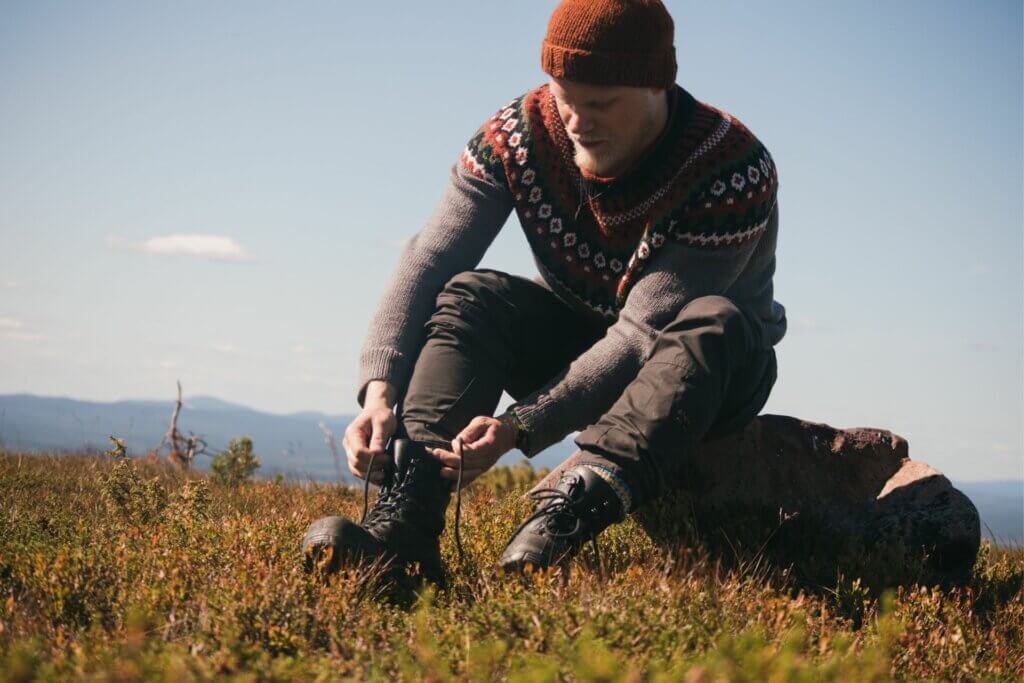
Part 2: Tetris!
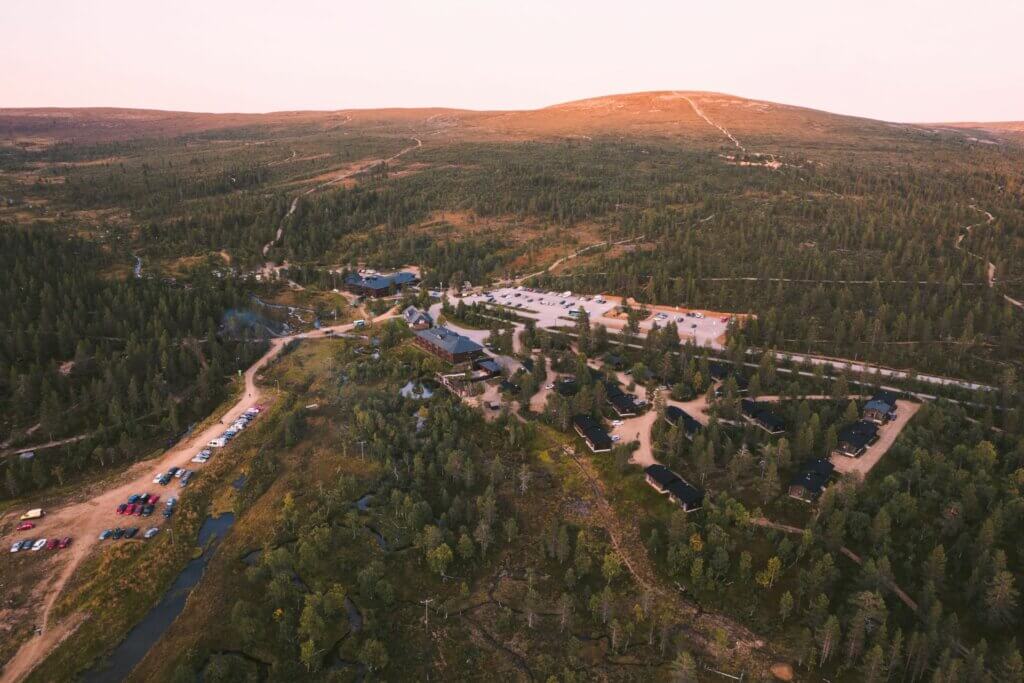
Part 3: A Backpack Full of Rhymes
The best concerts happen in the car. The landscape changes, and Spotify playlists grip me as tightly as the hip belt of my backpack. I notice that as I head farther north, Finnish artists get more playtime. Leading the charge are Eppu Normaali, Dingo, and Neljä Ruusua. Even the familiar songs gain new meanings along the way. My journey towards Kiilopää has finally begun. Let’s hope I remember to keep my karaoke moments confined to the car; otherwise, this week-long Fell Challenge will feel even longer for the others—haha.
The drive from Hyvinkää to Kiilopää covers about a thousand kilometers. I decided to take my time, stopping frequently and spending the night at a camping area near the Arctic Circle in Rovaniemi. What a wonderful place, I highly recommend it. Kemijoki also struck me as particularly beautiful. I planned my stops near swimming beaches. There were a few roadworks along the way, naturally extending my travel time. My plan to overnight during the trip was a good one. I arrived at Kiilopää right on time, maybe even a bit earlier. The E75 road had clear signs leading me straight to the Kiilopää parking lot.
When I stepped out of the car, I couldn’t help but smile. I passed cyclists, trail runners, and hikers carrying massive backpacks. It’s no wonder this is called the hub of outdoor activities. Even just stepping into the hotel, you feel that this is the place where everyone can find their preferred way to enjoy nature.
Inside the hotel, the reception and head guide, Satu, greet me warmly. It’s Tuesday now. Tomorrow my guiding training begins in earnest. Today, I’ll focus on settling in, familiarizing myself with the local area map, and of course, writing this blog. Fortunately, I still had time to go for a swim in the spring-fed mountain creek in the sauna world. Oh, it felt so good after the long drive! It reminded me of Japan and their onsens—hot springs. The only difference is that in our spring, the water temperature is ten degrees, while theirs is sixty.
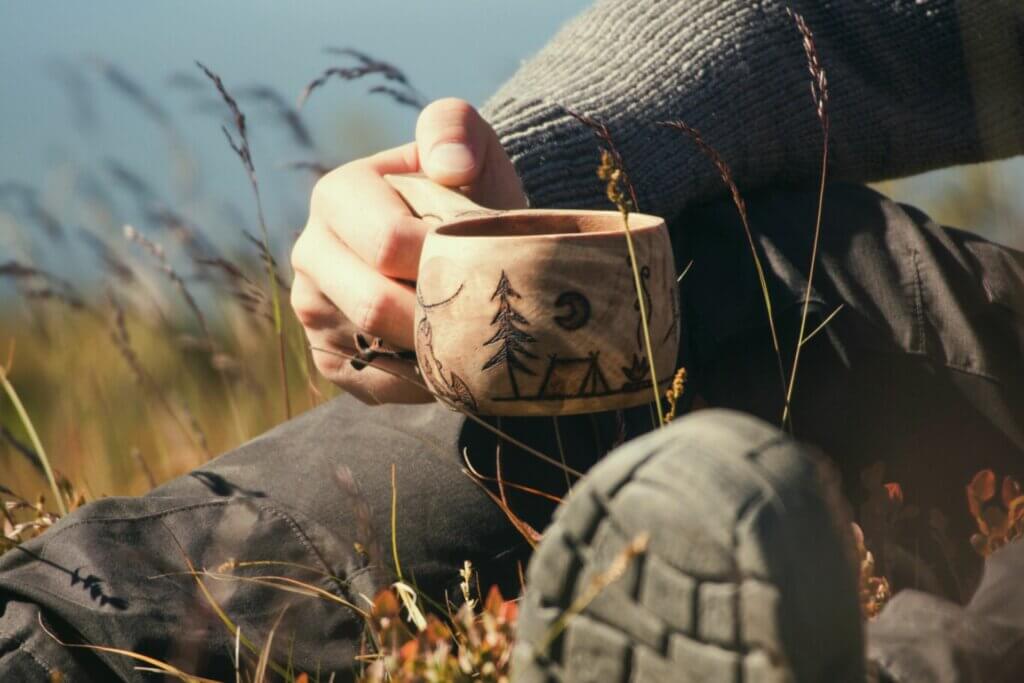
Part 4: Naturally in Nature
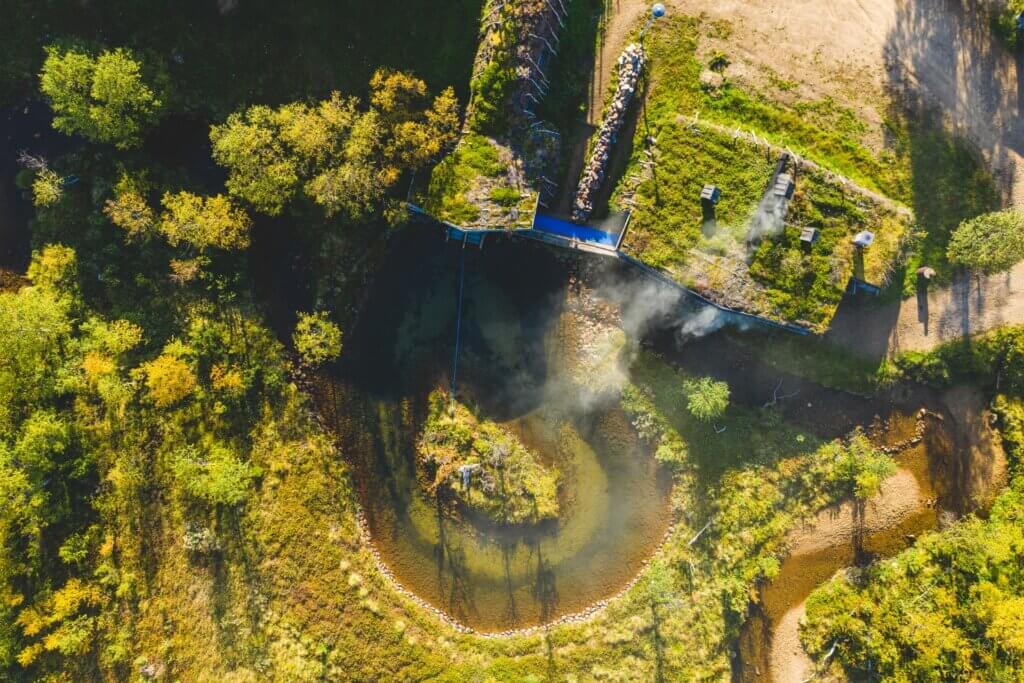
Osa 5: Suomen Latu Kiilopää
A good night’s sleep is behind me. I believe that yesterday’s smoke sauna and swim in the mountain stream positively impacted the quality of my sleep. And that, in my opinion, is one of Kiilopää’s greatest strengths. Here, you can disappear into the wilderness for weeks and then return to the comfort of the hotel accommodations when the need arises. Day trips are also a popular option. A new yoga studio is being built in the area, and I’ve heard that the yoga courses here are highly appreciated.
In the restaurant, breakfast, lunch, and dinner are always available. You can ask the wilderness guides for help with map reading, and at the equipment rental shop, you can rent gear for hikes and trips of various lengths. Kiilopää has also acquired a versatile selection of mountain bikes. The biking trails are well-marked. Equipment rental can be done on-site, but you can also book in advance via the website. The same principle applies to signing up for Kiilopää’s weekly programs.
You can stay in the hotel, or if you prefer, in a campervan or tent at designated spots. Clothes washing and drying are available in several places. In addition to the diverse services, the hotel staff is friendly and calm. All in all, it’s a place where people feel comfortable. The best hiking stories can be heard from guests during sauna nights, which take place every evening. And there are plenty of those!
Less than 24 hours to go and then we’re off! I can’t get too comfortable here haha. Today, I packed my backpack into its final shape, and its weight, without water, was about 25 kg. This evening, we have a shared pancake-making session with the participants of the Luirojärvi loop. We’ll also do some short introductions and go over the upcoming hike. I’m excited, I can’t wait for tomorrow morning. Let’s go already! I’ll continue this epic journey after the Luirojärvi loop. It’s amazing if you’ve managed to follow along this far. The best part of the story is still ahead.
Hold onto your mosquito hats, here we go!
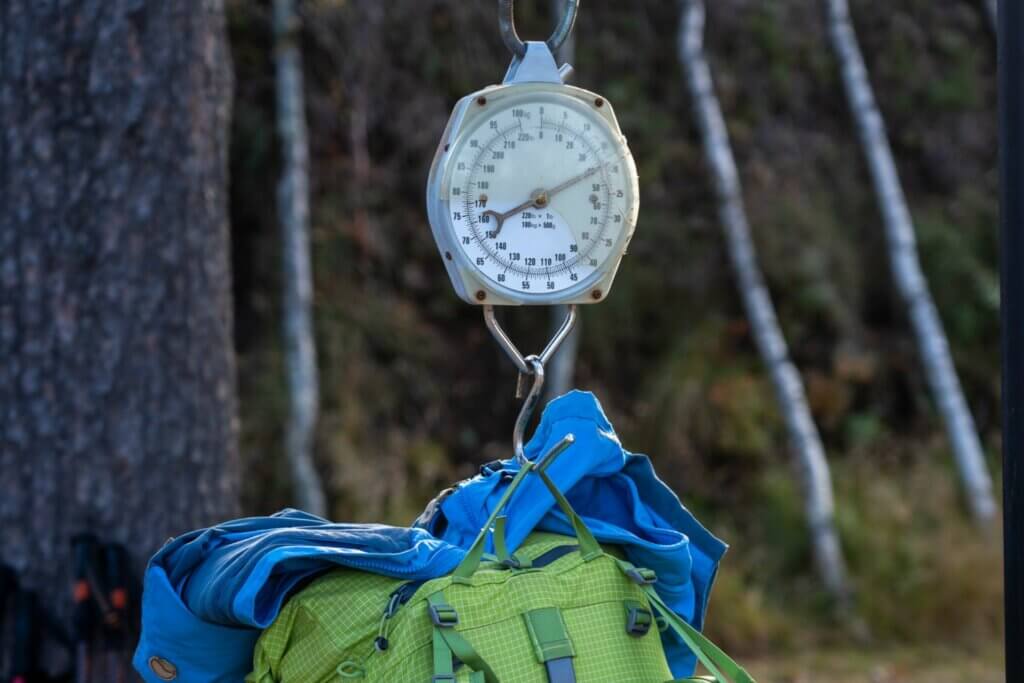
Osa 6: Kiilopää – Suomunruoktu
It’s hard to believe it was the end of the week and Friday morning when I think about how eagerly I jumped out of bed. Finally, I could strap on my backpack and start hiking. At breakfast, I scanned the room for possible clients joining the Luirojärvi loop. The weather outside was beautiful and warm. The clock was nearing 10:00, the planned departure time. Figures with various loads began to approach the starting point. Everyone had a focused look and a strong desire to get moving. And that suited us guides just fine, as the first day’s hike to the camp at Suomunruoktu was about 14 km.
A few last checks on gear, backpacks on the scale, and we were ready to go. We were accompanied by Kiilopää’s lead guide Satu and Niko, the lead guide for the Tuiskukuru loop. Our third guide, in addition to Anne and me, was Olli, who joined the Luirojärvi loop. There were five participants, as well as the lovely Halti dog. Everyone had previous hiking experience. To me, the first hiking day felt mostly like fine-tuning our group dynamics. What pace suits everyone, how long do we need breaks, and so on. We took as many breaks as we needed. If we felt like it, we slowed down the pace. It would never get dark. We also, of course, took photo breaks and identified different plants, trees, and birds. It was also possible to practice navigation.
So, we were on track in many ways. A big thanks for that goes to Olli. It quickly became clear to me that he had an incredible knowledge of the local area and a fantastic memory for identifying plants and birds. His storytelling effortlessly sped up the flow of the first day. Anne, in turn, had planned the day’s script very thoughtfully. She also gave great tips, such as advice on proper backpack-carrying posture.
Their calm and confident approach to map reading instilled a sense of security within the group. We wouldn’t miss any potential water refilling spots or snack breaks before the big mountain climb. I tried to keep an eye on the group’s pace and, especially on the first day, I probably acted as a brake in some instances. We aimed to avoid going too fast and making sudden speed changes. We needed to save enough energy for setting up camp when we arrived.
When we reached Suomunruoktu, we all began our own self-care. We set up tents and had a meal. A few of us even went for a swim in the mountain stream. Later in the evening, we had planned a shared mood check. We went over the day’s progress and other matters. As a summary, we guides agreed that everything related to the hike seemed to be really clear to our group right from the start. The only thing we noted was that drinking water was a bit lacking for everyone, so we’d pay closer attention to that in the following days.
Also, we’d aim to make sure our breaks were long enough so that everyone could take their backpacks off. The walking pace for the day was about 2.2–2.5 km/h, which was well-received. The hike from Kiilopää to Suomunruoktu took about eight hours. One of the highlights of the first day, in my opinion, was the gold miners’ sauna built in 1935, as well as identifying the theme plant of our trip, the blue nightshade leaf. All in all, it was a very clear and pleasant first day of hiking.
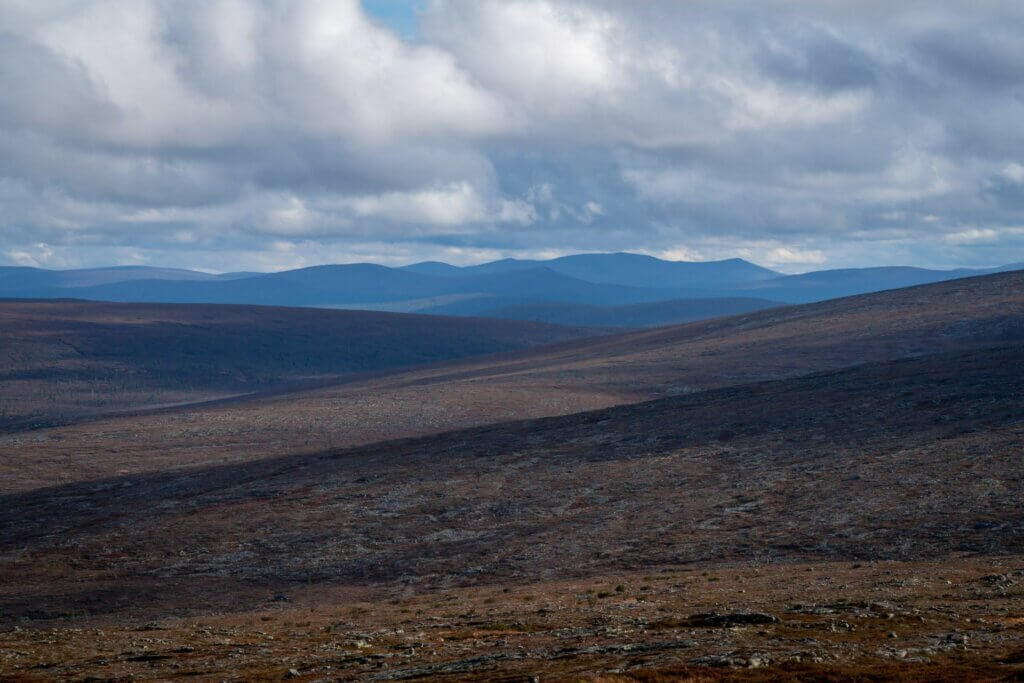
Osa 7: Suomunruoktu – Tuiskukuru
The alarm clock blared in the middle of the forest, jolting me awake. The first breakfast by the side of the river was accompanied by mosquitoes, some of which probably found their way into my porridge. My legs still felt like jelly from the previous day’s hike. Carrying the backpack didn’t seem like such a great idea anymore, unlike when we first left Kiilopää. The birds were singing and the endless night played tricks on my sleep. In the morning, I managed to break down the camp, eat breakfast, and visit the outhouse. The instruction was to be ready to leave at 10 AM, fully operational. A long day lay ahead, with a distance similar to the previous day’s hike—around 14 km.
Amid my morning routine, I found myself reflecting and realizing that the challenges and discomforts created by the environment are part of hiking. Could I find the positive sides of hiking amidst the mosquito swarm and still enjoy the less pleasant parts? Sometimes it’s too hot, sometimes too cold. Sometimes a mosquito bites you, sometimes an ant. Some paths are easy to walk, others can be dangerous. The perfect tent spot may already be taken, or there might not be one at all. You may have to drink suspicious-looking water because there are no other options for miles around.
It might rain, snow, or sleet. You carry things in your backpack you never needed during the whole trip. Blisters form on your feet from the very first day, and they’ll bother you for the rest of the journey. You cross water, sometimes ankle-deep, sometimes up to your waist. The fear of getting lost is always there. The energy demand and hunger follow their own rhythm in the wilderness. When you acknowledge these things and overcome them a few times, hiking becomes a lot more enjoyable. At least it has for me. And once you’ve experienced it, you don’t think about these things much anymore. How did everyone else’s first morning go?
Well, it had gone well. In front of me stood a rested group of explorers, ready for adventure. Our journey continued as planned at around 10 AM toward Tuiskukuru. I remember that today everyone got to know each other better while walking in the line. The pace was relaxed and really calm, with long breaks. We teased Olli with tricky questions about the national park.
Perhaps this is why I have the least memories of this section of the trip. The great discussions about gear and hiking made the kilometers fly by. This was also the most tiring day for me. The second day tends to be like this on my trips, so I didn’t think too much about it. I only noticed it when my focus started to waver, for example, in observing my surroundings. My gaze began to drop from the beautiful forests to the backpack cover of the hiker in front of me. I did notice that the deeper we went into the park, the more magnificent the old forests and the twisted pines (kelos) became. The Tuiskukuru campsite was on top of a tall hill, while the hut was at the bottom. We traveled at about the same pace as the day before and arrived at the Tuiskukuru hut early in the evening. The next day, we would reach the turning point of our trip—the legendary Luirojärvi!
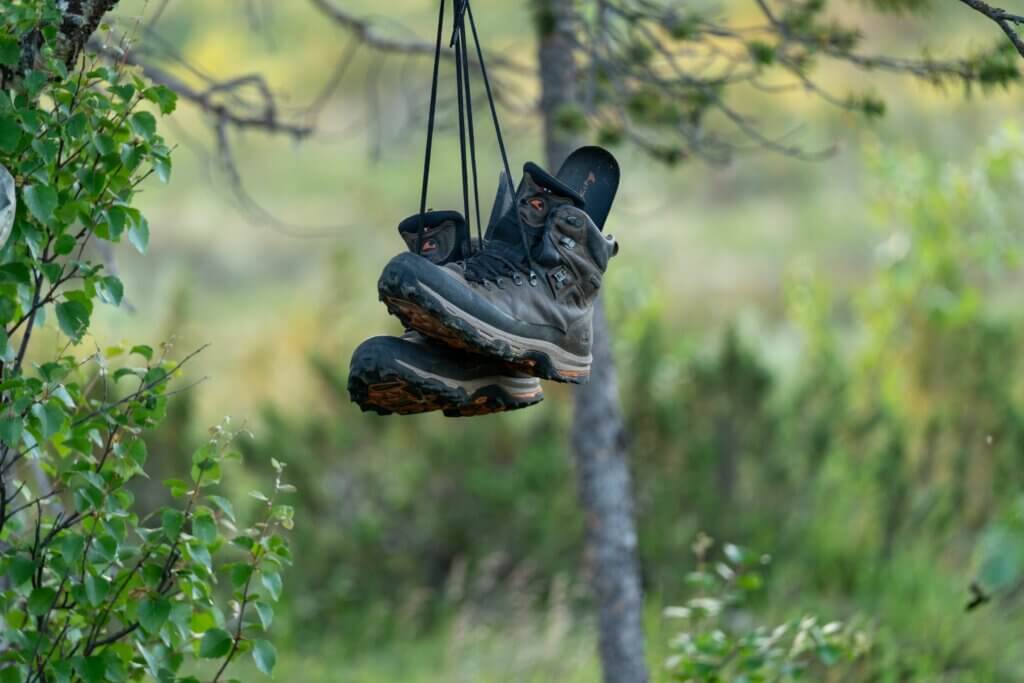
Osa 8: Tuiskukuru-Luirojärvi
Red whortleberries, bog rosemary, cotton grass, and meadow cranesbill—these are just a few of the familiar plants we encountered along our hiking trails. The fells were adorned with mountain birch and dwarf birch, while the forests were filled with various mossy areas, as well as pine and spruce. In some places, there were even areas that could be classified as bogs. The Siberian jays (Kuukkeli) frequently came around my hammock, curious and watchful. By the water, we saw common goldeneyes and tufted ducks. In the forest, we encountered grouse, including the ptarmigan. Everywhere, there were nettles, mosquitoes, midges, and horseflies.
Large lichen fields were rare, and we didn’t see reindeer along our route, even though they were common in the Kiilopää area. During the whole week, I didn’t hear a single airplane or car. Surprisingly few other hikers were around, and the huts were always empty.
So far, the weather had been absolutely perfect. The temperature was well over 10°C, and flowers bloomed earlier than usual. The water levels were low, making crossings easier. Even at night, the temperature didn’t drop below 7°C, so it wasn’t too cold to sleep. The third day turned out to be the most beautiful in terms of weather, and the hike itself was the shortest of all, just about 8 km.
There was also time to create unforgettable moments off the beaten path. This was where Olli stepped in. He had spotted a potential viewpoint on the map where we could see Luirojärvi and Sokosti from a beautiful angle. The fells looked amazing not only from the top but also from different perspectives.
When we reached Luirojärvi, we were met by a real welcoming committee. News of our group’s progress had reached the huts from other hikers several days earlier. This is how information spreads in nature. Even in the middle of nowhere, everyone seems to know where you are. The weather was sunny, and a new evening/night group was preparing to conquer Sokosti. The lake and the warm sauna tempted me to stay in camp.
I managed to set up my hammock beautifully close to the water, with a stunning view of the fells. The fatigue was hidden beneath a feeling of well-being and success. The same was evident in all of us. The next day would be a rest day, and everyone could do whatever they wanted. The midges, however, were unbelievable. During the night, my shelter wasn’t pestered by rain but by hundreds, no, thousands of midges. There was no escaping them.
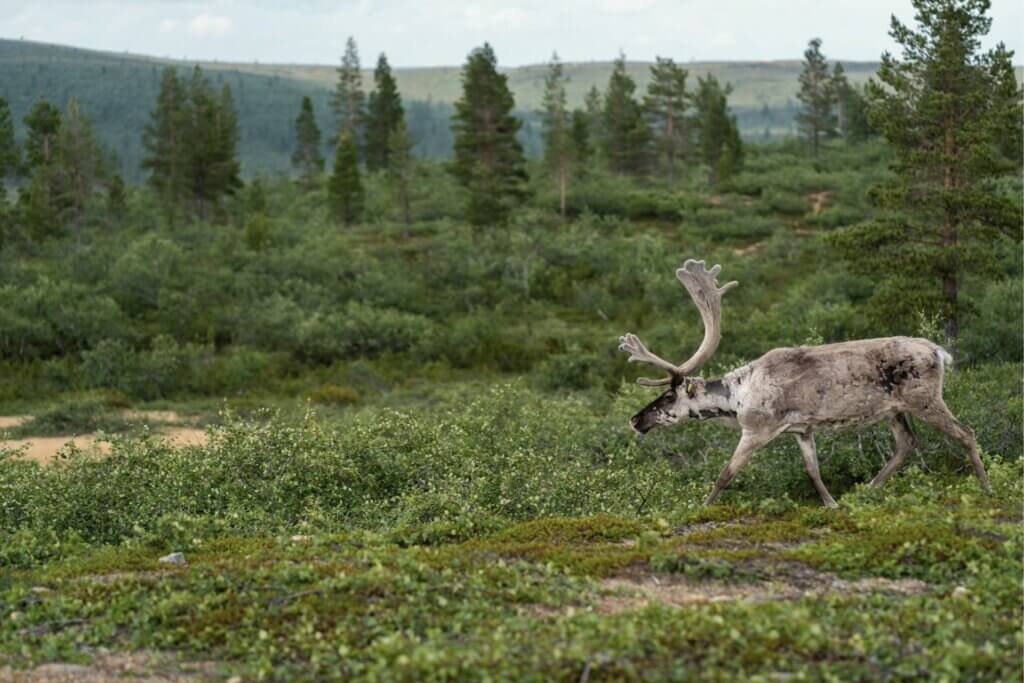
Osa 9: Luirojärvi – Sokosti
The next morning, it was a wonder I could see anything through the mosquito net. The midges were so numerous. I poured out black clumps from my plastic bags—chaotic running around, and then I hurried up to the hut to have breakfast. The sauna and swim from the previous evening had done wonders for my recovery, and I felt quite energetic. At breakfast, I decided that I, too, would summit Sokosti. I couldn’t get anyone else excited about the idea, so I’d go solo.
My plan was to move quickly with minimal gear: a map, trekking poles, a water bottle, and a handful of nuts were all I needed. My steps felt light and quick. It felt almost strange to walk without a backpack. I quickly approached the Tuiskukuru area, and the climb up Sokosti revealed itself in all its glory. Up the rocky slope I went, admiring the views. I decided to stop about 200 meters from the top to assess where the weather fronts for the day were heading. My heart raced, and sweat poured down.
An hour and 20 minutes had passed since I started. It was a good, energizing exercise session. But that’s where my ascent ended. A rain front was approaching the area. The rocky Sokosti would hardly be pleasant in the rain. Plus, I was alone. Keeping risks to a minimum, I decided to turn around and quickly walked back to the Luirojärvi hut to prepare lunch. The rain started only after I had descended from the fell. I highly recommend anyone staying in the area to go to Sokosti, at least to the slopes of Tuiskukuru. The views from there are magnificent!
The theme for the rest of the day was refueling. The next day would be the longest hiking stage of the Tunturihaaste, nearly 20 km. I ate and drank much more than on previous days. The freeze-dried pasta bolognese tasted surprisingly good. I also managed to drink a packet of electrolyte powder. My feet had no blisters, thanks to the leukotape. We had a communal campfire in the evening, and it seemed like everyone had managed to recover fairly well from the previous days. The next day’s departure would be at 8:00 AM. By Tuesday evening, it was expected to start raining, and we aimed to reach Kotaköngäs before then.
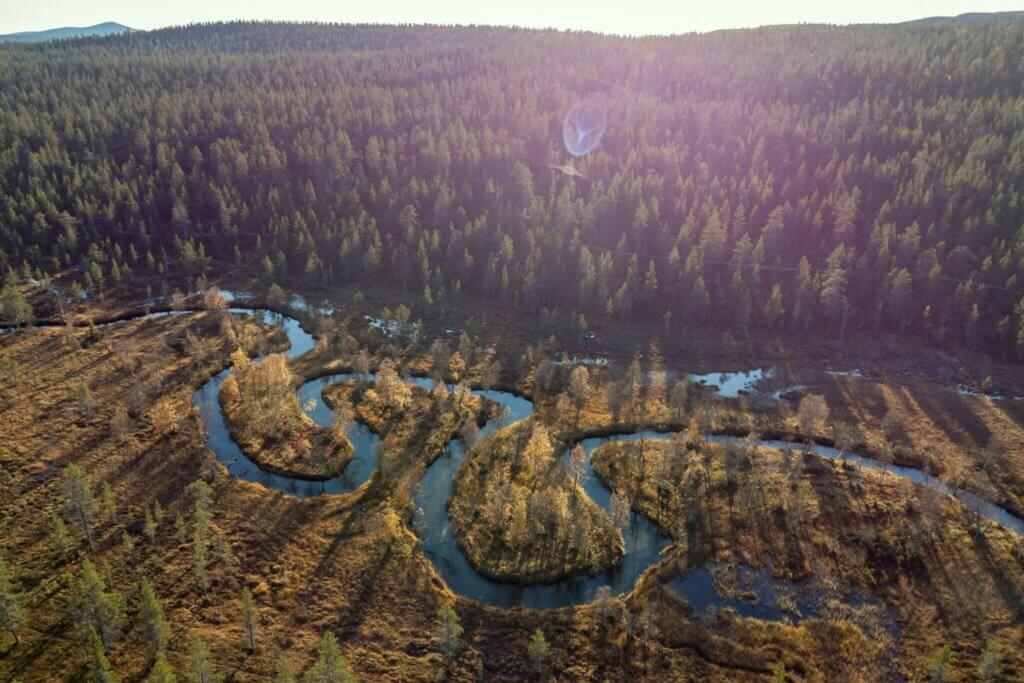
Osa 10: Luirojärvi – Kotaköngäs
In the morning, our group set off energetically towards Kotakönkää. A long day ahead. Everyone had a great opportunity to practice some map reading. We crossed rivers up and down, did the same thing again, and before the next river, a sharp right turn. We repeated this as a group, saying it out loud, and we turned at the right spot. We basically followed the Palovanganjoki river or its branches all day. The nature around the water was lush and green. For a moment, I even forgot that we were walking surrounded by fells. The weather was warm and oppressively hot. It felt like it could really start raining in the evening.
Around halfway through, we had a quick meeting and decided to speed up to make it to our destination before the rain started.
During breaks, Olli continued with his incredibly detailed lectures on the park’s history. Olli also recommended books and authors related to the area. This kind of addition to completing the Tunturihaaste is invaluable. The stories and legends deepen your connection with the landscape, and you begin to understand what has happened, where, and when. Plus, the journey passes by almost unnoticed. Without a doubt, I’ll take this to heart and try, at least on some level, to learn about local history wherever I go. The Tunturihaaste has challenged me in dozens of ways and shown me how much more there is to learn about moving in nature. Awesome. Step by step. More thanks!
When we reached Kotakönkä, the light rain began. I went to dip my tired feet into the cold river water. The second half of the journey was completed at about 3–3.5 km/h. Luckily, the weight of the backpack had already lightened significantly compared to the first day. It was a good idea from the event organizers to place the longest hike towards the end of the Tunturihaaste. Tomorrow, we would have a short journey of less than ten kilometers to Rautulampi, where we would meet the second group of the Tunturihaaste, the Lankojärvi circle hikers. It would be interesting to hear about their journey as well.
Speaking of groups, I made an interesting observation about those of us on the Luirojärvi circle. Over the course of the week, we had learned to work well as a team. We already knew each other a bit and our individual ways of acting. Our shared practices and rules had become automatic. Non-verbal communication had increased. The clients would have done wonderfully without us guides by their side.
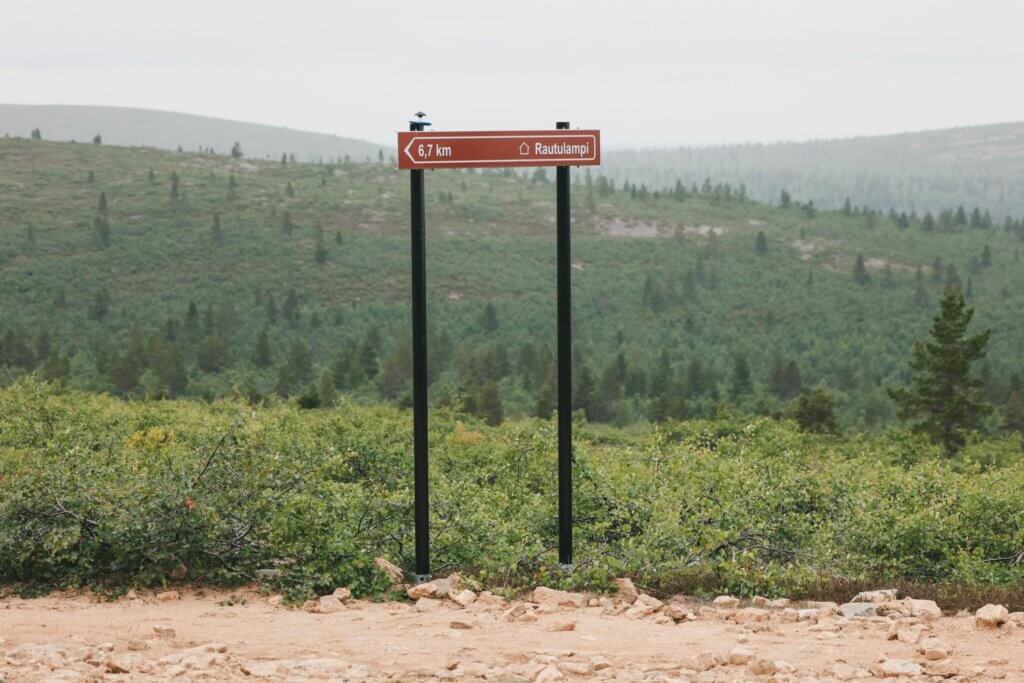
Osa 11: Kotaköngäs – Rautulampi
The most memorable part of this day was the heavy rainfall. In just one day, 31 mm of rain fell—over half of the average monthly rainfall for June in Saariselkä. All our clothes and shoes were soaking wet, and it was hard to see ahead due to the downpour. The Lankojärvi group had arrived at the Rautulampi huts before us, and the atmosphere was quite tight. The new cabins looked great.
The most used area was the shared drying room. Everything went in there, and we lit a fire in the stove. Fortunately, my change of clothes had stayed dry inside my backpack. Unfortunately, I made a small mistake: my hammock got wet. My new storage bag wasn’t waterproof after all. I had tested or knew how to use all other gear, but this was something I hadn’t anticipated. Well, it wasn’t catastrophic, but it was still a surprise. Luckily, I had alternatives. I could have slept in the cabin or in someone else’s tent. We were also only about 10 kilometers away from the Kiilopää hotel.
However, I decided on this: I would try to dry the hammock in the drying room and sleep outside. If it didn’t dry in time, I could sleep in the cabin. To my surprise, the hammock dried quickly, and I managed to set up my camp outside in the rain. It felt great. The warmth of the cabin was definitely an inviting option when tired and wet. It wasn’t about showing anything to others, just about me having a dry shelter with me again. I could see others shaking their heads as I ran between the drying room and the cabin, haha.
It’s important to remember that at any moment, more tired and wet hikers could arrive in the area. At that point, it’s courteous to make space and stay outside if the cabin is running out of room. The Rautulampi area was the hardest place to find suitable trees for a hammock. There were only a few good spots, and even those were mostly flat tent sites. Fortunately, I found good trees a little higher up by the stream. A little tip for future adventurers!
Later in the evening, we began planning the final day’s stage with all the guides. The clients had different time preferences and route preferences. Now, we had the opportunity to utilize all six guides. We decided to split into four groups:
- Group 1: Move quickly without a lunch break and leave early in the morning.
- Group 2: Leave ahead of the main group and move quickly through the fells and the Kiilopää summit.
- Group 3: The main group, moving at a relaxed pace along marked routes.
- Group 4: Break away from the main group at the Kiilopää fell and go to the summit.
This division of labor would allow us to accommodate everyone’s wishes while ensuring safety and comfort on the last stretch of the journey.
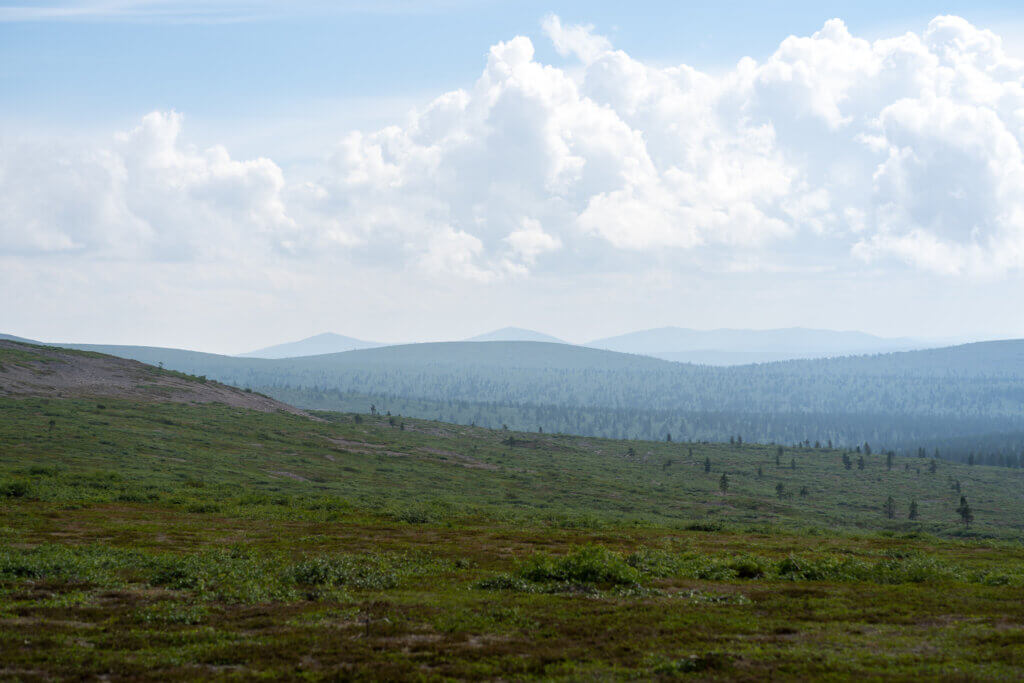
Osa 12: Rautulampi – Kiilopää
The weather that day was downright poor. It rained, and it was cold. I set out in the morning with the main group. During the lunch break, I made a smart move: I swapped into my thickest jacket and dry socks. I even put plastic bags over my socks because my hiking boots were still wet from the previous day’s rain. The warmth began to spread through my body.
As we approached Suomen Latu Kiilopää, I began reflecting on the entire journey. Where did I succeed? Where could I improve? What comes next after Tunturihaaste? Where did we visit, and what was my favorite spot? During this challenge, I multitasked in a way: I was both a client and a wilderness guide, writing and drafting this blog while also training with Suomen Latu. Over the course of the week, we walked 73 km. We spent six nights camping and hiked for seven days. There was heat, frost, rain, the midnight sun, fells, and river crossings.
The experience was, in short, incredible. Anne agreed. At the weigh-in at the departure gate, my backpack weighed only 19 kg. Had I been carrying rocks? No, just food. A lot of it. For the first time, it felt like I had managed to eat enough during this long stretch of hiking. And it was surprising that all the plastic waste fit into a small bread bag. I used every piece of gear and clothing I had packed in my backpack.
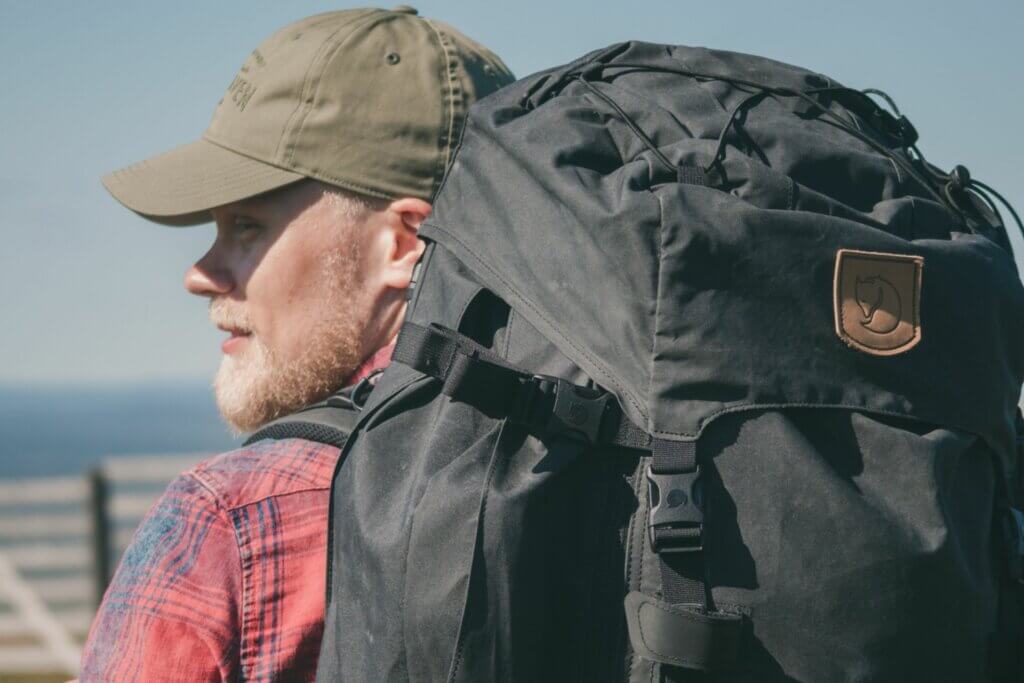
Osa 13: Kiilopää Fell Challenge
On Friday, June 20th, the Tunturihaaste culminated in a shared experience in the traditional smoke sauna followed by a pizza gathering. During this time, everyone received Tunturihaaste-themed necklaces as a reward for their successful completion of the challenge. It was time to say our goodbyes and head off to celebrate Midsummer.
Personally, Tunturihaaste has given me unforgettable experiences, knowledge, and skills. If you feel like you don’t want to or are not ready to hike alone, this event is perfect for you. The entire Tunturihaaste can also be completed solo if desired. Accommodation options include tents, cabins, or huts. The event is safe and well-organized. Suomen Latu Kiilopää Hotel serves as an excellent base for the event. With this experience, I can wholeheartedly recommend participating in this event.
I wanted to capture my entire Tunturihaaste experience in the spaces between the lines. I hope I succeeded in doing so and that the result has inspired you to take part in the event or even just to embrace hiking in general.
Joonas Puhakka